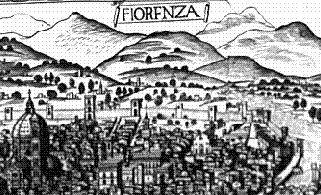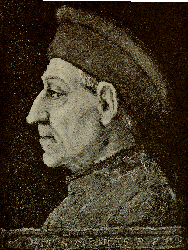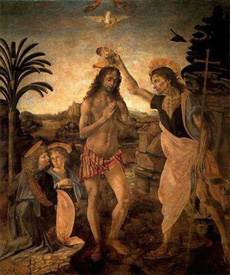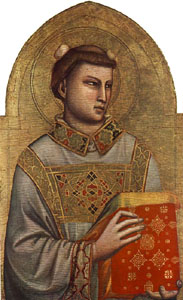![]()

![]()
What was significant about the Medici family, and why were its members able to stay in power for so long?
![]()

The Italian Renaissance was a time of rebirth. The era was exemplified by experimentation in government, art, psychology and sociology. Florence was the city at the forefront of all of these developments. An example of Florence's influence on the Renaissance and its city-state neighbors is the florin, Florence's minted coinage that became the standard currency across all of Europe.
At the birth of Florence as an Italian Renaissance city-state is the medieval papacy. The Holy Roman Empire was constantly at war with the papacy, weakening its hold upon the regions that it governed. Slowly, Florence and other urban centers in Italy formed autonomous city-states that closely resembled those of the ancient Greeks. These city-states were rich urban centers whose elite class had the money, freedom and time to explore the arts.
Young Florence was ruled by rich merchants and aristocracy. The Italian city-states were not only plagued by internal battle between the classes, but also between each other. City-states waged wars against each other to gain control of the Mediterranean. It was these battles that spawned experimentation in government. The Florentines explored republicanism and humanism.
Humanism played a large role in the Florentine republic. It was an intellectual movement that strongly influenced the psychology of early Florentine government. The movement encompassed man and how he related to the world. Gone were the days of medieval fate-driven existence. Humans suddenly awoke to a new world where the future wasn't written for them. People no longer saw involvement in the arts as blasphemous, nor did they see education as only something limited to the clergy. Petrarch, often considered to be one of the fathers of Humanism, established the belief that humanism was a civic duty. Humanism and higher philosophy concerned not only the government officials, but also the general populace. In this way, Florence's emphasis on humanism as a civic duty is much like Greece's emphasis on the polis as an ideal way of life.
By the middle of the fifteenth century, Florence was a thriving city-state with a population of 60,000. Its ruling body consisted mainly of twelve rich merchant guilds that congregated at the Palazzo Vecchio to vote and discuss city issues. Florence found its wealth in commerce and industry, not in land holdings as earlier societies had. The Florentine republic discovered techniques that are characteristic of modern diplomacy, such as the establishment of embassies, intelligence reports, balance of power and alliances with other city-states. The most famous of these alliances was the Peace of Lodi, established in part by a then rich Florentine banker, Cosimo Medici. The Peace of Lodi successfully stopped the constant warring between city-states, establishing a peace that lasted until the invasion of King Charles VIII.
Boiling under the surface were the condottieri, despotic rulers, who sought to take control of the young city-states and re-establish one-man rule. Out of all of the powerful Italian city-states, Florence was one that held out the longest. But even Florence fell to despotic rule, eventually, with the rise of the Medici family.

Cosimo Medici
The Medici family rule effectively began with Cosimo Medici who took over his father’s bank in 1429. Within five years, he gained significant political power in Florence, but it wasn’t until his grandson, Lorenzo, destroyed the Florentine republican constitution in 1480 that the Medici family rule was solidified. The Medici family established a hereditary monarchy in Florence, the successors of Lorenzo having ruled until they were kicked out of Florence by Girolamo Savonarola in 1494.
The Medici family contributed to Florence in many ways. With the rise of a hereditary monarchy came a change in public philosophy. No longer considered a civic duty, humanism became a movement that applied to aristocrats the royal family. With ruling power out of the hands of the public, it was now the sole duty of the ruling class to live up to humanist ideals of morality, ethics and learning.
Florence was a clear leader in all realms of Renaissance art, including sculpture, architecture and painting. The city-state gave birth to such names as Michelangelo Buonarroti and Raphael Santi. At the root of Renaissance art was the rejection of medieval Gothic art and the rebirth of ancient Grecian art. Medieval art was concerned with somber spiritual themes, and while Renaissance art was still concerned with the spiritual aspect of things, it expressed a sense of control over one’s own destiny that medieval art did not have. In this way, humanism pervaded Renaissance art. This new art form was called the International Style.

Leonardo da Vinci's Baptism of Christ
Filippo Brunellesci led the Florentine classical revival. He was an architect who successfully developed the use of perspective in art and explained it in mathematical terms. He is known for his work on the Bapistry doors, as well as his crucifix that resides in St. Maria Novella. Leonardo da Vinci, a late Renaissance artist, is most commonly known for the Mona Lisa, but he was also an engineer and a scientist. Although he was not born in Florence, he contributed to Florentine art and life. It was in Florence that Leonardo began his apprenticeship in 1466 with Andrea del Verrocchio. He went on to travel throughout the Italian city-states, spreading his knowledge of human anatomy, mechanics, engineering and, of course, art. The Florentine artists of the Renaissance were experimentalists in every sense of the word. They personalized art, and sought to explain it scientifically.
Florence was a shining example of the best of the Italian Renaissance. In politics Florence thrived, fostering new intellectual movements, such as humanism, as well as experimentation in governmental administration. Much of modern government and society stands on the shoulders of Florentine giants. The strong rule of the Medici family kept Florence in the forefront of the Renaissance, and established a peace between the city-states that lasted over 40 years. Florence excelled artistically, as well. Well-known artists, such as Leonardo da Vinci and Raphael Santi, found their footing as Florentine apprentices. Sculptors and architects, such as Filippo Brunellesci, gave to the world beautiful pieces of art that stand to this day, a tribute to their skill and craftsmanship. Florence was the epitome of Italian Renaissance glory.
![]()

Gold Florin
1252 - Minting of the first gold Florin
1299 - Palazzo Vecchio was built. The Palazzo Vecchio was the home of the ruling guilds of early Florence.
1350 - Italian Renaissance begins
1378 - Revolt of the Ciompi (wool-workers) in Florence. An example of the lower class wishing to take part in Florentine government.
1397 - Giovanni de Medici moves to Florence, and begins to take part in Florentine public life.
1401 - Filippo Brunellesci and Ghiberti win the rights to sculpt the northern doors of the Bapistry, a Florentine church. They take 28 years to complete them.
1429 - Cosimo de Medici takes over his father's bank, and within five years has political control over Florence.
1453 - Constantinople falls to the Ottoman Turks, sending many Greeks, and their influential art, to the Italian city-states.
1454 - Peace of Lodi was created mainly through the efforts of Cosimo Medici. The Peace of Lodi effectively ended warring between the city-states for the next 40 years.
1464 - Lorenzo de Medici ascends to power in Florence.
1466 - Leonardo da Vinci begins his apprenticeship in Florence.

1480 - Lorenzo de Medici completes the destruction of the Florentine republican constitution, signaling the complete triumph of despotic rule over Florence.
1486 - Pico publishes his collection of 900 treatises, and is declared a heretic by the Catholic Church. Lorenzo de Medici saves him from death.
1494 - The Medici family is kicked out of Florence by Girolamo Savonarola. The French King Charles VIII took Florence without a single shot, and briefly occupied it before returning to France.
1513 - The Florentine, Machiavelli, wrote The Prince.
6 May 1527 - Rome is sacked by the Spanish imperial army, an event that signifies the downfall of the Renaissance.
1600 - Italian Renaissance Ends.
![]()

Drawing of a Face of an Angel, by Leonardo da Vinci
This website shows a family tree of the Medicis. Renaissance Humanism focuses on the social movement of the same name which was very prominent during that time. A comprehensive site on Italian Renaissance art is The Italian Renaissance Art Project, a database of images and biographies of major artists. Also focusing on art, Leonardo da Vinci is a very fun site that has very detailed information on da Vinci's life. This section of The Florentine Chronicle has the text of a primary source from 1348 that describes the effects of the Bubonic Plague on Florence.
![]()

St. Stephen, by Giotto
There are a plethora of books published on the Italian Renaissance and Florence. A great book on all aspects of Florence and the Italian Renaissance, including politics and the church, is Gene Adam Brucker, Renaissance Florence (1983). Christopher Hibbert, The House of Medici: Its Rise and Fall (1999), follows the lives of the Medici family, a dynasty of Florentine rulers during the Renaissance. David Klapisch-Zuber, Women, Family and Ritual in Renaissance Italy (1987), is a detailed look into the daily life of Renaissance families. Two books that explore the art of Renaissance Florence exclusively are Elizabeth Pilliod, Pontormo, Bronzino, and Allori: A Geneaology of Florentine Art (2001) and Antonio Paolucci, The Origins of Renaissance Art: The Baptistery Doors, Florence (1996).